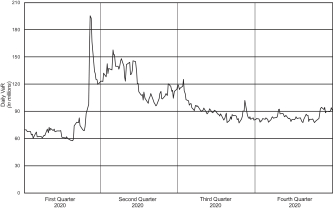THE GOLDMAN SACHS GROUP, INC. AND SUBSIDIARIES
PART I
Item 1. Business
Introduction
Goldman Sachs is a leading global financial institution that delivers a broad range of financial services across investment banking, securities, investment management and consumer banking to a large and diversified client base that includes corporations, financial institutions, governments and individuals. Our purpose is to advance sustainable economic growth and financial opportunity. Our goal, reflected in our One Goldman Sachs initiative, is to deliver the full range of our services and expertise to support our clients in a more accessible, comprehensive and efficient manner, across businesses and product areas.
When we use the terms “Goldman Sachs,” “we,” “us” and “our,” we mean The Goldman Sachs Group, Inc. (Group Inc. or parent company), a Delaware corporation, and its consolidated subsidiaries. When we use the term “our subsidiaries,” we mean the consolidated subsidiaries of Group Inc. References to “this
Form 10-K”
are to our Annual Report on Form 10-K
for the year ended December 31, 2020. All references to 2020, 2019 and 2018 refer to our years ended, or the dates, as the context requires, December 31, 2020, December 31, 2019 and December 31, 2018, respectively. Group Inc. is a bank holding company (BHC) and a financial holding company (FHC) regulated by the Board of Governors of the Federal Reserve System (FRB). Our U.S. depository institution subsidiary, Goldman Sachs Bank USA (GS Bank USA), is a New York State-chartered bank.
Our Business Segments
We report our activities in four business segments: Investment Banking, Global Markets, Asset Management, and Consumer & Wealth Management. Investment Banking generates revenues from financial advisory, underwriting and corporate lending activities. Global Markets consists of Fixed Income, Currency and Commodities (FICC) and Equities, and generates revenues from intermediation and financing activities. Asset Management generates revenues from management and other fees, incentive fees, equity investments, and lending and debt investments. Consumer & Wealth Management consists of Wealth management and Consumer banking, and generates revenues from management and other fees, incentive fees, private banking and lending, and consumer-oriented activities.
The chart below presents our four business segments and their revenue sources.

Investment Banking
Investment Banking serves public and private sector clients around the world. We provide financial advisory services, help companies raise capital to strengthen and grow their businesses and provide financing to corporate clients. We seek to develop and maintain long-term relationships with a diverse global group of institutional clients, including corporations, governments, states and municipalities. Our goal is to deliver to our institutional clients all of our resources in a seamless fashion, with investment banking serving as the main initial point of contact.
Investment Banking generates revenues from the following:
| • | Financial advisory. |
| • | Underwriting. |
| Goldman Sachs 2020 Form 10-K | 1 |


